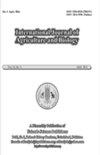有机氮和无机氮双重标记在水稻叶面施肥中的应用;迁移和同化机制
Q2 Agricultural and Biological Sciences
引用次数: 0
摘要
采用13C-15N双标记有机和无机氮在水稻分蘖期直接施用于品种C两优266叶片上的同位素示踪方法,分析了有机和无机氮在水稻各器官中的吸收、转运和同化机制。结果表明:甘氨酸氮和铵态氮处理水稻各器官干重和氮积累量显著高于其他处理;水稻各器官的干重和氮积累均呈现“叶>根>茎”的格局,对照与硝态氮处理间差异不显著。各处理的根、茎、叶均有15N增量,呈现出一定的“叶>茎>根”的格局;各脏器15N增量间差异极显著(P < 0.01)。水稻根、茎、叶和全株的13C增量/15N增量比值分别为0.108、0.158、0.178和0.161。在甘氨酸N和铵态氮处理下,水稻叶片中GOT、GPT和GDH活性最高,茎部次之,根部次之;对照(Ck)和硝态氮组的GOT、GPT和GDH活性为“叶>根>茎”。结果表明:水稻叶片直接吸收和利用分子甘氨酸,且甘氨酸的吸收率显著高于铵态氮和硝态氮;水稻植株中N的可转运性由高到低依次为:氨基酸N >铵态N >硝态N©2022 Friends Science Publishers本文章由计算机程序翻译,如有差异,请以英文原文为准。
Foliar Fertilization of Dual-Labeled Organic and Inorganic N in Rice; Mechanisms of Transport and Assimilation
The absorption, transport, and assimilation mechanism of organic and inorganic nitrogen(N) in rice organs were analyzed by applying 13C-15N dual-labeled organic and inorganic N directly to the leaves of rice plants (variety: C Liangyou 266) at tillering stage based on isotope tracing. The findings suggest that the dry weight and N accumulation of various rice organs under glycine N and ammonium N treatments were significantly higher than other treatments; the dry weight and N accumulation in rice organs followed the pattern of “leaf > root > stem”, and there were no significant differences between control and nitrate N treatment. The 15N increments were detected in the roots, stems and leaves of all treatments, showing a certain pattern of “leaf > stem > root”; there were significant differences between the 15N increments of various organs (P < 0.01). The 13C increment/15N increment ratios of rice root, stem, leaf, and whole plant were 0.108, 0.158, 0.178, and 0.161 respectively. For rice plants treated by glycine N and ammonium N, the activity of GOT, GPT and GDH peaked in leaves, followed by stems and then roots; while the pattern of activity for GOT, GPT and GDH in the control (Ck) and nitrate N group was in following order “leaf > root > stem”. The results showed that rice leaves directly absorb and utilize molecular glycine and the absorption rate of glycine is significantly higher than ammonium N or nitrate N. Molecular organic N absorbed into rice leaves would be transported to roots; the transportability of N in rice plants ranked in descending order is as follows: amino acid N > ammonium N > nitrate N. © 2022 Friends Science Publishers
求助全文
通过发布文献求助,成功后即可免费获取论文全文。
去求助
来源期刊

International Journal of Agriculture and Biology
AGRICULTURE, MULTIDISCIPLINARY-
CiteScore
1.70
自引率
0.00%
发文量
40
审稿时长
5 months
期刊介绍:
Information not localized
 求助内容:
求助内容: 应助结果提醒方式:
应助结果提醒方式:


